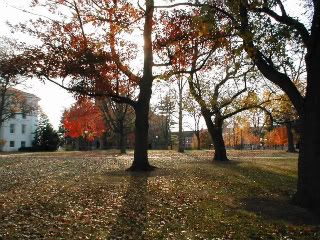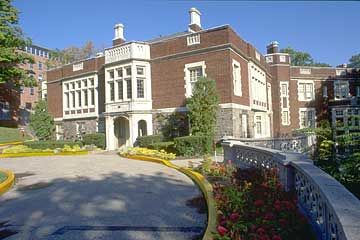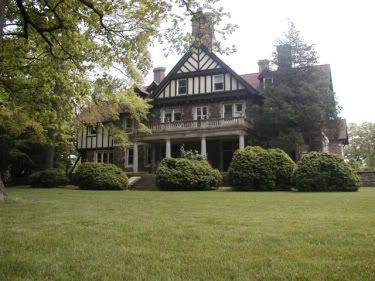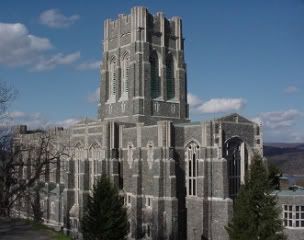
Gettysburg College Campus from Wikipedia
Founded as Pennsylvania College in 1832, Gettysburg College in Adams County was a sister institution to the Lutheran Theological Seminary.
During the Battle of Gettysburg, the school's Pennsylvania Hall was used by both sides as a field hospital and communications outpost as the tides of the battle ebbed and flowed.
The school even had its' own troops, the 26th Pennsylvania Emergency Militia Regiment. They actually got into combat with light casualties, although over 100 of the students were taken prisoner. No wonder their team nickname is the Bullets.
It became Gettysburg College in 1921. President Dwight David Eisenhower was heavily involved with the institution and even had an office there that still bears his name. Some of the spooky occurrences on campus have been shown on the Travel Channel, the History Channel, and NBC's Unsolved Mysteries.
-- Brua Hall: This is the home of the Performing Arts department and Kline Theatre, once the college Chapel. It's haunted by the spook of an older Civil War officer called the General.
He's been seen in the catwalks and backstage, and enjoys playing pranks with the props and costumes. He also likes watching the performances, and has his own center stage seat that depresses when he sits in it and pops back up when he leaves. The student actors make sure it's always empty, just in case the General wants to catch the show.
-- Glatfelter Hall: The legend goes that a young couple climbed the bell tower of Glatfelter in a suicide pact. The girl jumped, but the guy changed his mind. Her spook has since been seen on the bell tower, but only by males. It seems she's trying to lure a fellow to jump for her, to replace her cowardly beau and join her ever after in the afterlife. The 1887 structure is the computer science center now, so GC techies, beware if you hear her siren call.
-- Pennsylvania Hall (Old Dorm): Built in 1837, this is the oldest building on campus. It was used as a command post and hospital during the Battle of Gettysburg, and it's said that the spook of a guard - the Lone Sentinel - can still be seen in the building's cupola (although some tales say there are three guards marching around the outpost; they even disagree as to Blue or Gray). It was also used as a hospital.
The Old Dorm's most famous story, as related by Mark Nesbitt in Ghosts of Gettysburg, involves two administrators on the elevator. Passing the intended stop, it went down to the basement, where the doors opened to an operating Civil War hospital.
The women were terrified watching the doctors at work, performing meatball surgery on their patients - and watching the growing pile of amputated limbs stacked up in the corner. The scene was completely silent, but when one of the blood soaked doctors approached them, they hit every button on the elevator and escaped.
The spook doc probably thought they were a couple of nurses coming to help him, but they weren't about to stick around to find out, just in case he was looking for a ticket out of the OR. The women found a guard and went back downstairs, suspecting a student prank, but the basement was empty except for some boxes when they arrived. It's never been experienced again, but if it happened once...
-- Red House: This off campus apartment house is generally occupied by women attending GC. It's said that the grave of a Civil War era girl is in the backyard, and she haunts the house. You can tell she's around when you smell her lilac perfume in the home or when she pulls one of her poltergeist tricks like moving things around or breaking dishes.
-- 60 Chambersburg Street: The building has been standing since 1863, but the section in question was added later. It is reported that the off-campus apartment is haunted by a make-yourself-at-home ghost named Chuck. He whistles around the apartment for hours on end, and turns electronic appliances on and off. Once, it's alleged, he even rewound the VCR to watch a scene he liked again. It's also reported that once Chuck lifted a woman's hair off her shoulder and made it stand straight out on the other side of her head.
-- Stevens Hall: There's one very well know ghost, the Blue Boy, haunting this Hall, which opened in 1868. The story goes that a young ward fled from the brutal Homestead orphanage and was given shelter by a couple of girls in their dorm room one icy winter night at what was then Pennsylvania College Prep School.
The house mother knocked on the door, and the girls hid the boy outside on a window ledge because he would surely be returned to the orphanage if found. The weather was bitter, and the house mother stayed and chatted for an hour. She finally left, but when the girls went to get the child, he was gone. He had wandered off and left nothing behind but footprints in the snow.
We don't know exactly what happened to the poor lad, but ever since girls staying in that room have been visited by his spook. It has frozen blue lips. He's also been seen peering into Steven's windows, faced pressed against the pane.
As for his window, it's known to fly open whenever there's a winter storm - even when it's locked. Once a girl saw him, shook her head in disbelief at the sight, and when she focused again, he was gone. But the words "Help Me" were written in reverse on the icy pane. This is another tale made famous by Mark Nesbitt in Ghosts of Gettysburg.
There's a lady ghost that's been spotted roaming the halls of Stevens, but we don't have her story. There are also tales of whispers coming from the attic, voices of children, and the spirit of a young girl that looks at herself in the dorm mirrors. You can see her reflection, but not her. The hall was a girl's prep school from 1911 - 1935, and that's where these spirits are thought to come from.
-- Stine Lake: OK, nothing spooky here, just a bit of GC lore. Before the Musselman Library was built, the quad outside of its' present location would flood whenever it rained and turn into a gooey, muddy bog.
The quad picked up the nickname Stine Lake (No, we don't know why. If you do, give us a yell), and it's still called that today, much to the consternation of frosh and visitors looking for a campus pond. In actuality, the quad's been high and dry since the late 1970s when the drainage was unclogged and updated. It's also the center for many campus April Fool pranks and the College's Springfest.
-- Theta Chi House: The urban legend here is that a previous owner of the house hung himself in the basement. If you're unfortunate enough to see his ghost hanging, you or someone close to you will run into bad luck. The fraternity must have run out of luck - the Theta Chi's are no longer on campus. Maybe everyone was in the basement at a kegger and the ghost appeared, cursing them to the next life.




